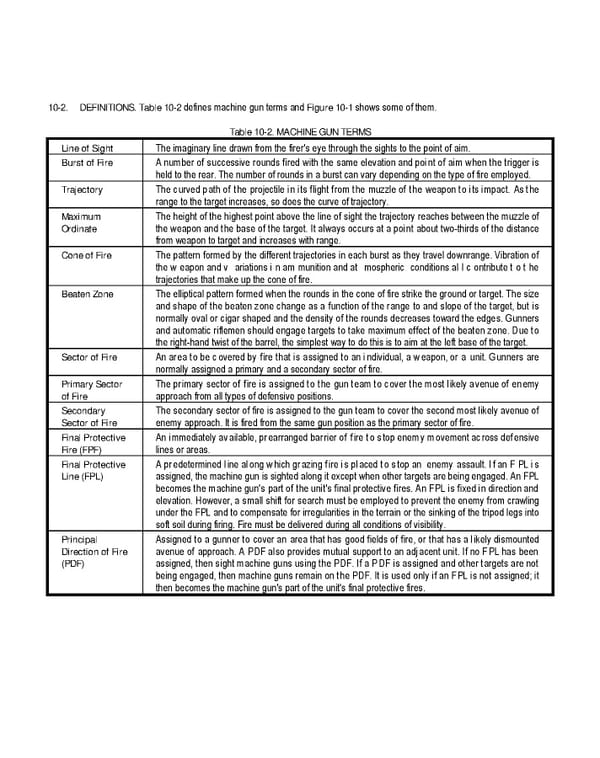10-2. DEFINITIONS. Table 10-2 defines machine gun terms and Figure 10-1 shows some of them. Table 10-2. MACHINE GUN TERMS Line of Sight The imaginary line drawn from the firer's eye through the sights to the point of aim. Burst of Fire A number of successive rounds fired with the same elevation and point of aim when the trigger is held to the rear. The number of rounds in a burst can vary depending on the type of fire employed. Trajectory The curved path of the projectile in its flight from the muzzle of the weapon to its impact. As the range to the target increases, so does the curve of trajectory. Maximum Ordinate The height of the highest point above the line of sight the trajectory reaches between the muzzle of the weapon and the base of the target. It always occurs at a point about two-thirds of the distance from weapon to target and increases with range. Cone of Fire The pattern formed by the different trajectories in each burst as they travel downrange. Vibration of the w eapon and v ariations i n am munition and at mospheric conditions al l c ontribute t o t he trajectories that make up the cone of fire. Beaten Zone The elliptical pattern formed when the rounds in the cone of fire strike the ground or target. The size and shape of the beaten zone change as a function of the range to and slope of the target, but is normally oval or cigar shaped and the density of the rounds decreases toward the edges. Gunners and automatic riflemen should engage targets to take maximum effect of the beaten zone. Due to the right-hand twist of the barrel, the simplest way to do this is to aim at the left base of the target. Sector of Fire An area to be c overed by fire that is assigned to an i ndividual, a w eapon, or a unit. Gunners are normally assigned a primary and a secondary sector of fire. Primary Sector of Fire The primary sector of fire is assigned to the gun team to cover the most likely avenue of enemy approach from all types of defensive positions. Secondary Sector of Fire The secondary sector of fire is assigned to the gun team to cover the second most likely avenue of enemy approach. It is fired from the same gun position as the primary sector of fire. Final Protective Fire (FPF) An immediately available, prearranged barrier of fire to stop enemy movement across defensive lines or areas. Final Protective Line (FPL) A pr edetermined line along w hich grazing fire is placed to s top an enemy assault. If an F PL is assigned, the machine gun is sighted along it except when other targets are being engaged. An FPL becomes the machine gun's part of the unit's final protective fires. An FPL is fixed in direction and elevation. However, a small shift for search must be employed to prevent the enemy from crawling under the FPL and to compensate for irregularities in the terrain or the sinking of the tripod legs into soft soil during firing. Fire must be delivered during all conditions of visibility. Principal Direction of Fire (PDF) Assigned to a gunner to cover an area that has good fields of fire, or that has a likely dismounted avenue of approach. A PDF also provides mutual support to an adjacent unit. If no FPL has been assigned, then sight machine guns using the PDF. If a PDF is assigned and other targets are not being engaged, then machine guns remain on the PDF. It is used only if an FPL is not assigned; it then becomes the machine gun's part of the unit's final protective fires.
 Ranger Handbook Page 197 Page 199
Ranger Handbook Page 197 Page 199